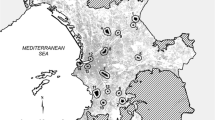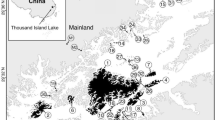Abstract
Context
Environmental processes and dispersal are primary determinants of metacommunity dynamics. The relative importance of these effects may vary between species of different abundance classes, given variation in life history traits. Under high disturbance conditions, rare species may be more easily eliminated from their optimal habitats and their distribution may therefore be more heavily dependent upon dispersal from nearby habitat patches than common species.
Objectives
We tested if metacommunity dynamics vary between abundance classes in a high disturbance environment.
Methods
Standardized butterfly sampling was conducted in the urban parks of Hong Kong. To estimate the strength of environmental processes, we measured an array of environmental variables for all sampled parks. Spatial predictors were generated to estimate the effect of dispersal.
Results
For shaping common species compositions, we found environmental processes (and specifically environmental variables including floral density and surrounding woody plant cover) slightly more important than spatial processes. For rare species, only spatial processes were significant while environmental processes were insignificant. Our result contrasts previous studies in natural metacommunities, which have shown that both common and rare species compositions are shaped by environmental processes and similar variables.
Conclusions
Our results demonstrate that high disturbance conditions may inhibit rare species establishment and persistence in urban landscapes. Local habitat management may not be sufficient in conserving rare species in urban environments—spatial context and configuration should be considered in planning for biodiversity. We also highlight the utility of community deconstruction analysis in providing insights into rare species metacommunity dynamics.




Similar content being viewed by others
References
Agriculture, Fisheries and Conservation Department (2011) A review of the local restrictedness of Hong Kong butterflies. Hong Kong Biodiversity 21:1–12
Alahuhta J, Johnson LB, Olker J, Heino J (2014) Species sorting determines variation in the community composition of common and rare macrophytes at various spatial extents. Ecol Complex 20:61–68
Blanchet FG, Legendre P, Borcard D (2008) Forward selection of explanatory variables. Ecology 89:2623–2632
Borcard D, Legendre P, Drapeau P (1992) Partialling out the spatial component of ecological variation. Ecology 73:1045–1055
Brommer JE, Fred MS (1999) Movement of the Apollo butterfly Parnassius apollo related to host plant and nectar plant patches. Ecol Entomol 24:125–131
Brown KS, Freitas AVL (2002) Butterfly communities of urban forest fragments in Campinas, São Paulo, Brazil: structure, instability, environmental correlates, and conservation. J Insect Conserv 6:217–231
Brückmann SV, Krauss J, Steffan-Dewenter I (2010) Butterfly and plant specialists suffer from reduced connectivity in fragmented landscapes. J Appl Ecol 47:799–809
Buschke FT, De Meester L, Brendonck L, Vanschoenwinkel B (2015) Partitioning the variation in African vertebrate distributions into environmental and spatial components—exploring the link between ecology and biogeography. Ecography 38:450–461
Census and Statistics Department (2012) Population census: summary results, p 131
Chan HSR, Chau WK, Cheng WK, Chow SM, Ho SCJ, Kan SCJ, Lau WHS, Ng KLE (2012) Encyclopedia of Hong Kong butterflies—search for butterflies. Hong Kong Lepidopterists’ Society Limited, Hong Kong
Chase JM, Amarasekare P, Cottenie K, Gonzalez A, Holt RD, Holyoak M, Hoopes MF, Leibold MA, Loreau M, Mouquet N, Shurin JB, Tilman D (2005) Competing theories for competitive metacommunities. In: Holyoak M, Leibold MA, Holt RD (eds) Metacommunities spatial dynamics and ecological communities. The University of Chicago Press, Chicago, pp 335–355
Chase JM, Myers JA (2011) Disentangling the importance of ecological niches from stochastic processes across scales. Philos Trans R Soc B 366:2351–2363
Chytrý M, Lososová Z, Horsák M, Uher B, Čejka T, Danihelka J, Fajmon K, Hájek O, Juřičková L, Kintrová K, Láníková D (2012) Dispersal limitation is stronger in communities of microorganisms than macroorganisms across Central European cities. J Biogeogr 39:1101–1111
Colwell RK (2013) EstimateS: statistical estimation of species richness and shared species from samples, version 9 and earlier. User’s guide and application. http://viceroy.eeb.uconn.edu/estimates/
Concepción ED, Moretti M, Altermatt F, Nobis MP, Obrist MK (2015) Impacts of urbanisation on biodiversity: the role of species mobility, degree of specialisation and spatial scale. Oikos 124:1571–1582
Cornwell WK, Ackerly DD (2010) A link between plant traits and abundance: evidence from coastal California woody plants. J Ecol 98:814–821
Cottenie K (2005) Integrating environmental and spatial processes in ecological community dynamics. Ecol Lett 8:1175–1182
Cunningham RB, Lindenmayer DB (2005) Modeling count data of rare species: some statistical issues. Ecology 86:1135–1142
da Silva PG, Hernández MIM (2015) Scale-dependence of processes structuring dung beetle metacommunities using functional diversity and community deconstruction approaches. PLoS One 10:e0123030
Dray S (2013) SpacemakeR: spatial modelling. R package version 0.0-5/r113. https://R-Forge.R-project.org/projects/sedar/
Dray S, Legendre P, Blanchet FG (2013) Pack for: forward selection with permutation (Canoco p 46). R package version 0.0-8/r109. https://R-Forge.R-project.org/projects/sedar/
Dray S, Legendre P, Peres-Neto PR (2006) Spatial modelling: a comprehensive framework for principal coordinate analysis of neighbour matrices (PCNM). Ecol Model 196:483–493
ESRI (2013) ArcGIS desktop: release 10.1. Environmental Systems Research Institute, Redlands, CA
Fahrig L (2013) Rethinking patch size and isolation effects: the habitat amount hypothesis. J Biogeogr 40:1649–1663
Fukumori K, Livingston G, Leibold MA (2015) Disturbance-mediated colonization—extinction dynamics in experimental protist metacommunities. Ecology 96:3234–3242
Hau BCH, Dudegon D, Corlett RT (2005) Beyond Singapore: Hong Kong and Asian biodiversity. Trends Ecol Evol 20:281–282
Heino J, Melo AS, Siqueira T, Soininen J, Valanko S, Bini LM (2015) Metacommunity organisation, spatial extent and dispersal in aquatic systems: patterns, processes and prospects. Freshwater Biol 60:845–869
Hong Kong Observatory (2014) Climatological information services in Hong Kong. http://www.hko.gov.hk/wservice/tsheet/climserv.htm
Jacobson B, Peres-Neto PR (2009) Quantifying and disentangling dispersal in metacommunities: how close have we come? How far is there to go? Landscape Ecol 25:495–507
Koh LP, Sodhi NS (2004) Importance of reserves, fragments, and parks for butterfly conservation in a tropical urban landscape. Ecol Appl 14:1695–1708
Law WY (1998) The use of butterflies for conservation evaluation in Hong Kong. Dissertation, The University of Hong Kong
Legendre P, Legendre LF (2012) Numerical ecology. Elsevier, Amsterdam
Legendre P, Mi X, Ren H, Ma K, Yu M, Sun IF, He F (2009) Partitioning beta diversity in a subtropical broad-leaved forest of China. Ecology 90:663–674
Leibold MA, Holyoak M, Mouquet N, Amarasekare P, Chase JM, Hoopes MF, Holt RD, Shurin JB, Law R, Tilman D, Loreau M, Gonzalez A (2004) The metacommunity concept: a framework for multi-scale community ecology. Ecol Lett 7:601–613
Leibold MA, Loeuille N (2015) Species sorting and patch dynamics in harlequin metacommunities affect the relative importance of environment and space. Ecology 96:3227–3233
Lennon JJ, Beale CM, Reid CL, Kent M, Pakeman RJ (2011) Are richness patterns of common and rare species equally well explained by environmental variables? Ecography 34:529–539
Lizée M-H, Manel S, Mauffrey J-F, Tatoni T, Deschamps-Cottin M (2011) Matrix configuration and patch isolation influences override the species—area relationship for urban butterfly communities. Landscape Ecol 27:159–169
Logue JB, Mouquet N, Peter H, Hillebrand H (2011) Empirical approaches to metacommunities: a review and comparison with theory. Trends Ecol Evol 26:482–491
Magurran AE, Henderson PA (2003) Explaining the excess of rare species in natural species abundance distributions. Nature 422:714–716
Muster C, Meyer M, Sattler T (2014) Spatial arrangement overrules environmental factors to structure native and non-native assemblages of synanthropic harvestmen. PLoS One 9:e90474
Nabout JC, Siqueira T, Bini LM, Nogueira IDS (2009) No evidence for environmental and spatial processes in structuring phytoplankton communities. Acta Oecol 35:720–726
Ng IY, Carr C, Cottenie K (2009) Hierarchical zooplankton metacommunities: distinguishing between high and limiting dispersal mechanisms. Hydrobiologia 619:133–143
Nowicki P, Vrabec V, Binzenhöfer B, Feil J, Zakšek B, Hovestadt T, Settele J (2013) Butterfly dispersal in inhospitable matrix: rare, risky, but long-distance. Landscape Ecol 29:401–412
Økland RH (1999) On the variation explained by ordination and constrained ordination axes. J Veg Sci 10:131–136
Oksanen J, Blanchet FG, Kindt R, Legendre P, Minchin PR, O’Hara RB, Simpson GL, Solymos P, Stevens MHH, Wagner H (2015) Vegan: community ecology package. R package version 2.3-2. https://cran.r-project.org/
Olivier T, Schmucki R, Fontaine B, Villemey A, Archaux F (2015) Butterfly assemblages in residential gardens are driven by species’ habitat preference and mobility. Landscape Ecol 31:865–876
Patton DR (1975) A diversity index for quantifying habitat “edge”. Wildl Soc Bull (1973–2006) 3:171–173
Pollard E, Yates TJ (1993) Monitoring butterflies for ecology and conservation. Chapman & Hall, Great Britain
R Core Team (2015) R: A language and environment for statistical computing. R Foundation for Statistical Computing, Vienna, Austria
Resh VH, Bêche LA, McElravy EP (2005) How common are rare taxa in long-term benthic macroinvertebrate surveys? J N Am Benthol Soc 24:976–989
Sattler T, Borcard D, Arlettaz R, Bontadina F, Legendre P, Obrist MK, Moretti M (2010a) Spider, bee, and bird communities in cities are shaped by environmental control and high stochasticity. Ecology 91:3343–3353
Sattler T, Duelli P, Obrist MK, Arlettaz R, Moretti M (2010b) Response of arthropod species richness and functional groups to urban habitat structure and management. Landscape Ecol 25:941–954
Schtickzelle N, Mennechez G, Baguette M (2006) Dispersal depression with habitat fragmentation in the bog fritllary butterfly. Ecology 87:1057–1065
Shwartz A, Turbé A, Julliard R, Simon L, Prévot A-C (2014) Outstanding challenges for urban conservation research and action. Glob Environ Chang 28:39–49
Siqueira T, Bini LM, Roque FO, Marques Couceiro SR, Trivinho-Strixino S, Cottenie K (2012) Common and rare species respond to similar niche processes in macroinvertebrate metacommunities. Ecography 35:183–192
Soininen J (2014) A quantitative analysis of species sorting across organisms and ecosystems. Ecology 95:3284–3292
Swan CM, Brown BL (2014) Using rarity to infer how dendritic network structure shapes biodiversity in riverine communities. Ecography 37:993–1001
Tam K, Bonebrake TC (2016) Butterfly diversity, habitat and vegetation usage in Hong Kong urban parks. Urban Ecosyst 19:721–733
Turlure C, Baguette M, Stevens VM, Maes D (2011) Species- and sex-specific adjustments of movement behavior to landscape heterogeneity in butterflies. Behav Ecol 22:967–975
Volkov I, Banavar JR, Hubbell SP, Maritan A (2003) Neutral theory and relative species abundance in ecology. Nature 424:1035–1037
Acknowledgments
We thank the Leisure and Cultural Services Department for permission to conduct fieldwork in the urban parks mentioned and Maria Lo for technical assistance. Two anonymous referees provided constructive criticisms to improve the manuscript. Everyone in the Global Change and Tropical Conservation Lab provided helpful comments on previous drafts of the manuscript. This work was generously supported by the University of Hong Kong.
Author information
Authors and Affiliations
Corresponding author
Electronic supplementary material
Below is the link to the electronic supplementary material.
Rights and permissions
About this article
Cite this article
Tsang, T.P.N., Bonebrake, T.C. Contrasting roles of environmental and spatial processes for common and rare urban butterfly species compositions. Landscape Ecol 32, 47–57 (2017). https://doi.org/10.1007/s10980-016-0427-1
Received:
Accepted:
Published:
Issue Date:
DOI: https://doi.org/10.1007/s10980-016-0427-1




